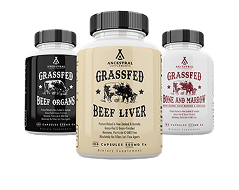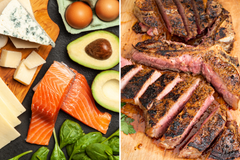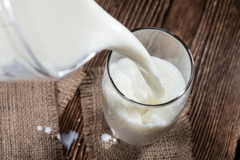The Ketovore Diet: A Comprehensive Guide to Combining Keto and Carnivore Eating Styles

Among people who are looking for ways to shed body fat, boost mental clarity, and improve other aspects of their overall health, the ketogenic (keto) and carnivore diets are popular approaches. These two low-carb diets share many of the same principles, and both have their advocates and unique benefits. So, what happens when you combine the two?
The "ketovore diet" is a hybrid eating style that integrates the high-fat, low-carb principles of keto with the entirely animal-based focus of the carnivore diet. Whether you're an experienced keto enthusiast or new to low-carb, high-fat eating, familiarizing yourself with the ketovore approach can open up an exciting new opportunity for optimizing your health.
In this article, we'll explore the fundamentals of the ketovore diet, discuss its potential benefits, and cover strategies for incorporating it into your lifestyle.
What Is the Ketovore Diet?
The ketovore diet blends the key principles of both the ketogenic and carnivore diets.
This ketovore diet is defined by:
- A combination of high-fat, low-carbohydrate keto principles with a focus on only animal-based foods, which is typical of the carnivore approach.
- Restriction of carbohydrate intake to a minimum while emphasizing high-quality animal proteins and fats.
By merging these two diets, "ketovores" can enjoy a wide array of animal-based proteins and healthy fats while keeping their carbohydrate intake in check.
This synergy helps to simplify meal planning—since only animal-derived foods and certain low-carb plant foods, including meat, organ meats, fish, nuts, and eggs, are eaten—and also harnesses the metabolic benefits of ketosis alongside the nutritional benefits of consuming whole animal foods.
Ketovore vs. Keto Diet vs. Carnivore Diet: What's the Difference?
The ketovore diet blends elements of the ketogenic and carnivore diets, but it is more flexible than a strict carnivore regimen.
This makes the ketovore diet, which can be considered a modified carnivore diet, an excellent option for anyone looking to benefit from the carnivore diet while retaining some of the diet diversity and flexibility found in the ketogenic approach.
Here’s a breakdown of how the ketovore diet differs from its counterparts:
- Foods included: Unlike the carnivore diet, which excludes all plant-based foods, the ketovore diet incorporates some low-carb plant foods. This is in contrast to the broader ketogenic diet, which allows for a wider variety of plant-based foods, including small amounts of fruits, vegetables, nuts, and seeds.
- Degree of restriction: The ketovore diet is more permissive than the zero-carb carnivore diet, providing a middle ground for those seeking the benefits of a primarily animal-based diet without completely eliminating plant foods.
And here's a low-carb diet comparison:
- Comparison to a standard keto diet: Ketovore is more restrictive in terms of carb intake and focuses more heavily on animal products.
- Differences from a strict carnivore diet: Ketovore allows for the inclusion of some plant-based foods (like greens and avocado) and small amounts of full-fat, unsweetened dairy, which are typically excluded in a strict carnivore diet that includes zero carbs.
- Similarities and differences with the Paleo diet: Both emphasize whole foods, but the ketovore diet restricts carbohydrate intake more significantly and emphasizes animal proteins more. For instance, a Paleo diet might include sweet potatoes, other root vegetables, and a variety of fruits, while the ketovore diet mostly eliminates these foods to keep carb consumption low.
Benefits of the Ketovore Diet
Adopting a ketovore diet can lead to a variety of health benefits, including:
1. Rapid Weight Loss and Body Fat Reduction
When you severely limit your carb intake and increase your protein and fat intake, your body turns to fat as its primary energy source, which can lead to significant weight loss and fat reduction.
A high-protein, high-fat ketovore diet is also very filling and tends to curb hunger. This usually makes it easier to consume fewer calories, which can encourage weight loss.
2. Improved Insulin Sensitivity and Blood Sugar Regulation
Low carb intake helps stabilize blood sugar levels and improve insulin sensitivity. By drastically cutting carbs on the ketovore diet, you help to reduce your risk of insulin resistance, diabetes, and metabolic syndrome.
In one study involving more than 250 respondents with either type 1 or type 2 diabetes, after adopting a carnivore diet, many with diabetes saw significant reductions in BMI and blood sugar levels, with many also reducing or discontinuing their diabetes medications. Specifically, all respondents with diabetes stopped using non-insulin injection medications, 84% stopped taking oral medications, and 92% of those with type 2 diabetes stopped using insulin.
3. Increased Mental Clarity and Focus
Many adherents of the ketovore diet say they experience improved focus and mental clarity due to the steady energy supply from fats in the absence of fluctuating glucose levels.
Some also find that they feel less hungry, don't experience cravings as often, and have more energy and motivation to be productive rather than focusing on eating frequently.
Additionally, there's some research showing that being in ketosis can generally support mental health due to its positive impact on glucose hypometabolism, neurotransmitter imbalances, oxidative stress, and inflammation.
4. Reduced Inflammation and Oxidative Stress
The ketovore diet's focus on whole, nutrient-dense foods—and the absence of processed foods and sugary snacks and beverages—can help to decrease inflammation and oxidative stress, which are among the root causes of many chronic health problems.
Experiencing less inflammation and oxidative stress can be helpful for managing and potentially improving conditions such as arthritis, type 2 diabetes, heart disease, and autoimmune disorders.
A study published in Frontiers in Nutrition also found that ketogenic and carnivore diets hold promise for the treatment of inflammatory bowel disease (IBD), including UC and Crohn's disease. This is thought to be due to the inverse association between intestinal ketone levels and IBD activity, as well as the therapeutic effects of elimination diets on levels of certain microbes in the gut.
Additionally, a ketovore approach may benefit those suffering from chronic pain and inflammatory skin conditions like eczema and psoriasis. And, by fighting inflammation, the diet may also enhance cognitive function and reduce the risk of neurodegenerative issues that are are more common with aging.
5. Simplified Meal Planning and Food Choices
The streamlined approach of the diet simplifies meal planning, shopping, and preparation, reducing the daily hassle of choosing what to eat. By focusing on a select group of foods, ketovore eliminates the often overwhelming complexity of diet choices, allowing you to dedicate more time and energy to other aspects of your life.
Foods to Eat on a Ketovore Diet
To reap the most benefits from a ketovore diet, focus on minimally processed, nutrient-dense, and high-quality foods, including:
- High-quality animal proteins: Include grass-fed beef, pasture-raised pork and poultry, wild-caught fish, and free-range eggs
- Organ meats and bone broth: Include these in your diet several times per week for a serious boost in vitamins and minerals, especially iron, zinc, B vitamins, and vitamin A
- Healthy fats: Opt for sources like butter, ghee, tallow, lard, and olive oil
- Low-carb, nutrient-dense plant foods: Incorporate avocados and leafy greens (like spinach, kale, and different lettuces) to boost your intake of antioxidants, vitamins, minerals, and fiber
- Keto-friendly dairy: Include small amounts of cheese and heavy cream for added fats
Foods to Avoid on a Ketovore Diet
To maintain the benefits of ketosis and overall health, avoid these foods:
- Processed and packaged foods: Foods like bread, cereal, yogurt, and desserts often contain hidden sugars, unhealthy fats, and additives that can affect gut health
- High-carb grains, legumes, and starchy vegetables: Avoid wheat, grains, beans, and potatoes
- Sugar and sweetened beverages: These disrupt blood sugar and prevent you from getting into and staying in ketosis
- Seed oils and hydrogenated fats: Oils like sunflower, safflower, corn, and canola oil can be inflammatory and are often found in processed foods that are low in nutrients
- Plant-based protein sources: While foods like soy and seitan provide protein, they are excluded due to their higher carb content
Implementing a Ketovore Diet
Implementing the ketovore diet involves strategically balancing your intake of fats, proteins, and carbs to maintain a state of ketosis, which is essential for reaping the full benefits of this diet.
Here's a detailed breakdown of the macronutrient ratios to aim for and how to manage these adjustments:
1. Transitioning from Standard to Ketovore Diet
- Gradual reduction of carbohydrates: Begin by lowering your carbohydrate intake to about 20–30 net grams per day, which is often sufficient to induce ketosis in most people without being overly restrictive.
- Increase animal fats and proteins: Compensate for the reduced carbohydrate intake by increasing your consumption of high-quality animal fats and proteins. This will not only help maintain satiety but also give your body the energy it needs.
2. Calculating Macronutrient Ratios and Calorie Needs
A typical macronutrient ratio on a ketovore diet might look like:
- 70–75% Fats
- 20–25% Proteins
- 5–10% Carbohydrates
- Daily carbohydrate limit: Once you're acclimated to the diet, keep your daily carbohydrate intake below 20 grams (aiming for about 10 to 15 grams per day, ideally) to ensure you stay in ketosis. This is crucial as exceeding this limit can disrupt the metabolic state that the ketovore diet aims to achieve. While this might seem very low, it's more carbs than a typical carnivore diet includes (which is zero).
- Protein and fat intake: Protein should be moderate, as high levels can convert to glucose and potentially kick you out of ketosis. Aim for about 1.0 to 1.5 grams of protein per kilogram of your body weight, depending on your activity level. Fill the rest of your daily caloric needs with healthy fats.
3. Meal Planning and Prep Strategies
Plan your meals to predominantly include sources of fat and protein, with a small amount of carbohydrates coming mainly from low-carb vegetables such as greens.
Focus on "quality over quantity" by seeking out high-quality, nutrient-dense foods to maximize the health benefits.
4. Monitoring Ketosis and Making Adjustments
Regularly use ketone testing strips to confirm that you are in ketosis. This will help you adjust your diet based on real-time feedback about your body's state.
If you're not in ketosis, adjust your carb intake downward and increase your fat intake. Similarly, if you experience fatigue or signs of protein deficiency, adjust your protein intake accordingly and pay attention to how these changes make you feel.
5. Incorporating Intermittent Fasting
Combining the ketovore diet with intermittent fasting can deepen ketosis, improve metabolic flexibility, and accelerate fat loss.
Start with shorter fasting windows (such as 16 hours of fasting with an 8-hour eating window) each day and gradually increase your fasting duration as your body adapts.
Is the Ketovore Diet Safe?
According to one study published in Current Developments in Nutrition, overall, people following a carnivore-type diet often experience few adverse effects (including nutrient deficiencies) and instead report health benefits and high satisfaction.
When side effects did occur in study participants, which was in less than 6% of people, they included diarrhea, constipation, weight gain, muscle cramps, hair loss or thinning, trouble sleeping, and dry skin. Participants reported high levels of satisfaction with the diet overall, noting no negative impacts on their social lives.
On the other hand, following a strict carnivore diet long-term may pose risks for heart health in some susceptible people. For those with a history of cardiovascular issues, including high cholesterol, it may be a better option to follow a higher-fiber diet (such as a modified keto diet) or to try a low-carb diet only for a short period of time, such as several months.
Potential Challenges and Solutions
While the ketovore diet has many benefits, it can also come with some potential challenges to be aware of:
1. Keto Flu and Electrolyte Imbalances
Ketosis can make some people feel lethargic or weak, especially when first following a very low-carb diet, during which your body needs time to adjust. You can help reduce "keto flu" (also called "carnivore diet flu") side effects by supplementing with electrolytes (which your body loses more rapidly while in ketosis) and staying well hydrated by drinking lots of water throughout the day.
2. Digestive Issues and Adaptation Period
Give your body time to adapt to a higher fat intake by starting slowly and increasing gradually. For example, give yourself about two or three weeks to transition from your typical diet to a ketovore diet by gradually cutting carbs and upping your protein and fat intake.
3. Social Pressures and Dining Out
It helps to plan ahead when eating out, such as by checking menus and making sure you'll have some low-carb options available. When dining out or at others' homes, focus on choosing simple, meat-based dishes, such as chicken, fish or beef, and greens.
4. Meeting Your Nutrient Needs
It's best to include a variety of animal-based foods in your diet to cover all nutrient bases, including organ meats, grass-fed beef, fish, eggs, and poultry.
Each of these foods provides different levels of essential nutrients—for example, organ meats like liver are very high in iron and vitamin A, eggs are rich in choline, and oily fish like salmon provide omega-3 fats. Switch it up to prevent boredom and also to consume a wider range of nutrients compared to when eating the same several foods on repeat.
5. Sustainability and Long-Term Adherence
You don't necessarily need to follow the ketovore diet every single day. You might choose to eat this way several times per week or to combine the ketovore diet with an approach like intermittent fasting for extra metabolic and weight loss support.
Find a balance that fits your lifestyle and preferences to maintain the diet more easily long term.
Conclusion: Ketovore Diet Benefits and Protocol
The ketovore diet is a powerful synthesis of the keto and carnivore diets. It offers significant health benefits, including weight loss, reduced risk for insulin resistance, and improved mental clarity. If you're looking to optimize your health while enjoying the benefits of both ketogenic and carnivore diets, the ketovore approach might be the ideal choice for you.



















